 EN4: Dynamics and Vibrations
EN4: Dynamics and Vibrations
Division of Engineering
Brown University
6.7 Free vibration of a damped, single degree of
freedom, linear spring mass system.
We analyzed vibration of several conservative systems in the preceding section. In each
case, we found that if the system was set in motion, it continued to move indefinitely.
This is counter to our everyday experience. Usually, if you start something vibrating, it
will vibrate with a progressively decreasing amplitude and eventually stop moving.
The reason our simple models predict the wrong behavior is that we neglected energy
dissipation. In this section, we explore the influence of energy dissipation on free
vibration of a spring-mass system. As before, although we model a very simple system, the
behavior we predict turns out to be representative of a wide range of real engineering
systems.
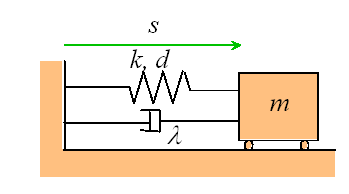
Problem: The spring mass dashpot system shown is released with velocity  from position
from position  at time
at time  . Find
. Find  .
.
Once again, we follow the standard approach to solving problems like this
You may have forgotten what a dashpot (or damper) does. Suppose we apply a force F
to a dashpot, as shown below:
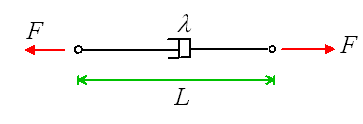
We would observe that the dashpot stretched at a rate proportional to the force

One can buy dampers (the shock absorbers in your car contain dampers): a damper
generally consists of a plunger inside an oil filled cylinder, which dissipates energy by
churning the oil. Thus, it is possible to make a spring-mass-damper system that looks very
much like the one in the picture. More generally, however, the spring mass system is used
to represent a complex mechanical system. In this case, the damper represents the combined
effects of all the various mechanisms for dissipating energy in the system, including
friction, air resistance, deformation losses, and so on.
To proceed, we draw a free body diagram, showing the forces exerted by the spring and
damper on the mass.
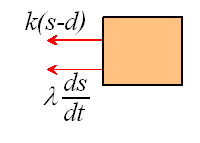
Newton II states that
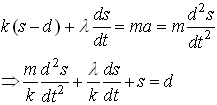
This is our equation of motion for s.
Now, we check our list of solutions to differential
equations, and see that we have a solution to:

We can get our equation into this form by setting

As before,  is known as the
natural frequency of the system. We have discovered a new parameter,
is known as the
natural frequency of the system. We have discovered a new parameter,  , which is called the damping
coefficient. It plays a very important role, as we shall see below.
, which is called the damping
coefficient. It plays a very important role, as we shall see below.
Now, we can write down the solution for x:
Overdamped System 

where 
Critically Damped System 

Underdamped System 

where  is known as the
damped natural frequency of the system.
is known as the
damped natural frequency of the system.
In all the preceding equations,

are the values of x and its time derivative at time t=0.
These expressions are rather too complicated to visualize what the system is doing for
any given set of parameters. The applet below might help. You can use the sliders to set
the values of either m, k, and  (in this case the program will calculate the values of
(in this case the program will calculate the values of  and
and  for you, and display the results), or alternatively,
you can set the values of
for you, and display the results), or alternatively,
you can set the values of  and
and
 directly. You can also choose
values for the initial conditions
directly. You can also choose
values for the initial conditions  and
and  . When you press `start’ the animation will show you the behavior of
the system, and a graph of the position of the mass as a function of time will be drawn.
You can also choose to display the phase plane, which shows the velocity of the mass as a
function of its position, if you wish. You can stop the animation at any time, change the
parameters, and plot a new graph on top of the first to see what has changed. If you press
`reset’, all your graphs will be cleared, and you can start again.
. When you press `start’ the animation will show you the behavior of
the system, and a graph of the position of the mass as a function of time will be drawn.
You can also choose to display the phase plane, which shows the velocity of the mass as a
function of its position, if you wish. You can stop the animation at any time, change the
parameters, and plot a new graph on top of the first to see what has changed. If you press
`reset’, all your graphs will be cleared, and you can start again.
Try the following tests to familiarize yourself with the behavior of the system
We now know the effects of energy dissipation on a vibrating system. One important
conclusion is that if the energy dissipation is low, the system will vibrate. Furthermore,
the frequency of vibration is very close to that of an undamped system. Consequently, if
you want to predict the frequency of vibration of a system, you can simplify the
calculation by neglecting damping.
6.8 Using Free Vibrations to Measure Properties
of a System
We will describe one very important application of the results developed in the
preceding section.
It often happens that we need to measure the dynamical properties of an engineering
system. For example, we might want to measure the natural frequency and damping
coefficient for a structure after it has been built, to make sure that design predictions
were correct, and to use in future models of the system.
You can use the free vibration response to do this, as follows.
First, you instrument your design by attaching accelerometers to appropriate points.
You then use an impulse hammer to excite a particular mode of vibration, as discussed in
Section 6.5. You use your accelerometer readings to determine the displacement at the
point where the structure was excited: the results will be a graph similar to the one
shown below.
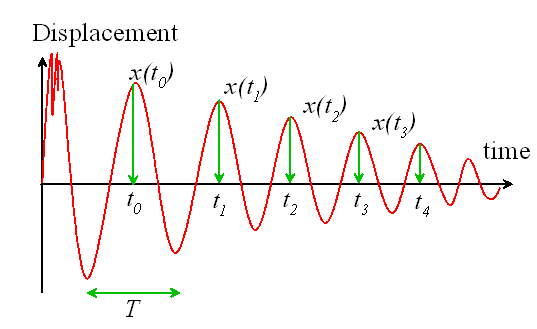
We then identify a nice looking peak, and call the time there  , as shown.
, as shown.
The following quantities are then measured from the graph:
1. The period of oscillation. The period of oscillation was defined in Section
6.2: it is the time between two peaks, as shown. Since the signal is (supposedly)
periodic, it is often best to estimate T as follows

where  is the time at which
the nth peak occurs, as shown in the picture.
is the time at which
the nth peak occurs, as shown in the picture.
2. The Logarithmic Decrement. This is a new quantity, defined as follows

where  is the displacement at the nth peak, as shown. In principle, you
should be able to pick any two neighboring peaks, and calculate
is the displacement at the nth peak, as shown. In principle, you
should be able to pick any two neighboring peaks, and calculate  . You should get the same answer, whichever peaks you
choose. It is often more accurate to estimate
. You should get the same answer, whichever peaks you
choose. It is often more accurate to estimate  using the following formula
using the following formula

This expression should give the same answer as the earlier definition.
Now, it turns out that we can deduce  and
and  from T
and
from T
and  , as follows.
, as follows.

Why does this work? Let us calculate T and  using the exact solution to the equation of motion for
a damped spring-mass system. Recall that, for an underdamped system, the solution has the
form
using the exact solution to the equation of motion for
a damped spring-mass system. Recall that, for an underdamped system, the solution has the
form

where 
Hence, the period of oscillation is

Similarly,

where we have noted that  .
.
Fortunately, this horrendous equation can be simplified greatly: substitute for T
in terms of  and
and  , then cancel everything you
possibly can to see that
, then cancel everything you
possibly can to see that

Finally, we can solve for  and
and  to see that:
to see that:

as promised.
Note that this procedure can never give us values for k, m or  . However, if we wanted to find
these, we could perform a static test on the structure. If we measure the deflection d
under a static load F, then we know that
. However, if we wanted to find
these, we could perform a static test on the structure. If we measure the deflection d
under a static load F, then we know that

Once k had been found, m and  are easily deduced from the relations
are easily deduced from the relations

 EN4: Dynamics and Vibrations
EN4: Dynamics and Vibrations
![]() from position
from position ![]() at time
at time ![]() . Find
. Find ![]() .
.












